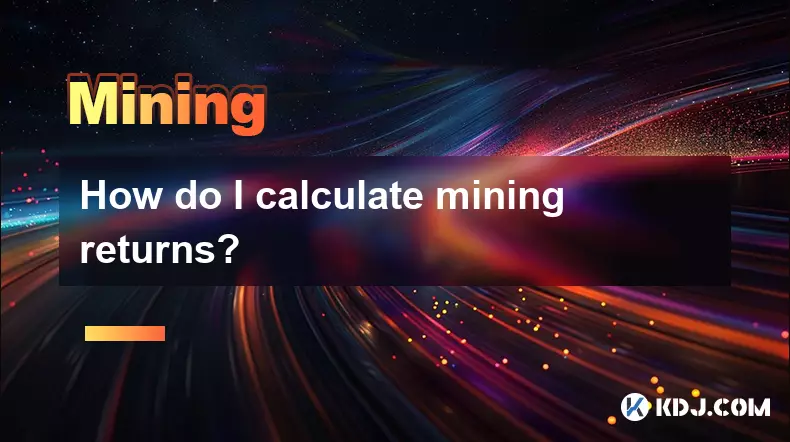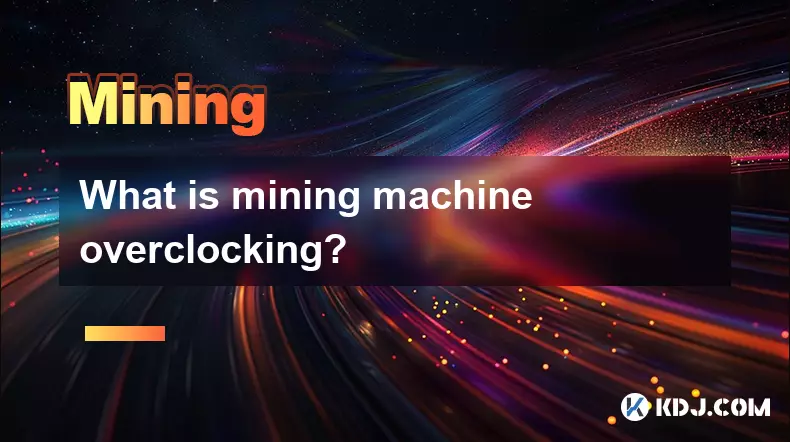-
 bitcoin
bitcoin $112195.049338 USD
2.42% -
 ethereum
ethereum $4124.915858 USD
2.81% -
 tether
tether $1.000570 USD
0.02% -
 xrp
xrp $2.861568 USD
2.25% -
 bnb
bnb $1000.346670 USD
3.04% -
 solana
solana $209.070819 USD
3.38% -
 usd-coin
usd-coin $0.999870 USD
0.02% -
 dogecoin
dogecoin $0.235379 USD
2.65% -
 tron
tron $0.335681 USD
-0.20% -
 cardano
cardano $0.803501 USD
3.38% -
 hyperliquid
hyperliquid $47.120881 USD
3.56% -
 chainlink
chainlink $21.501300 USD
3.44% -
 ethena-usde
ethena-usde $1.000571 USD
0.02% -
 avalanche
avalanche $29.793378 USD
3.62% -
 stellar
stellar $0.366964 USD
2.42%
How do I calculate mining returns?
To calculate mining profitability, assess your hardware's hash rate, power consumption, electricity costs, network difficulty, block rewards, and market prices while factoring in pool fees, cooling, maintenance, and equipment lifespan.
Sep 29, 2025 at 08:36 am

Understanding Mining Returns in Cryptocurrency
Calculating mining returns involves assessing multiple variables that affect profitability. The process requires a clear understanding of hardware performance, network difficulty, electricity costs, and the current market value of the mined cryptocurrency.
Determining Hash Rate and Power Consumption
1. Identify your mining hardware's hash rate.This metric, measured in hashes per second (e.g., MH/s, GH/s, TH/s), indicates how quickly your device can perform calculations. Higher hash rates increase the probability of solving blocks and earning rewards.
2. Measure power consumption in watts.Your miner consumes electricity, and this usage directly impacts profitability. Check the device specifications for wattage under full load.
3. Calculate daily energy usage in kilowatt-hours (kWh).Multiply the wattage by 24 hours, then divide by 1000 to convert to kWh. For example, a 3000-watt miner uses 72 kWh per day.
4. Multiply energy use by local electricity cost.If electricity costs $0.10 per kWh, running a 3000-watt miner for a day would cost $7.20.
5. Compare this cost against expected earnings.Energy expenses must remain below revenue to ensure profit.
Evaluating Network Conditions and Block Rewards
1. Monitor the blockchain’s current difficulty level.Difficulty adjusts over time to maintain consistent block times. As more miners join, difficulty increases, reducing individual returns.
2. Confirm the block reward for the cryptocurrency.Bitcoin, for instance, offers a fixed number of BTC per block, which halves periodically. Other coins may have different emission schedules.
3. Use online mining calculators to estimate daily earnings.Websites like WhatToMine or CryptoCompare allow inputting hash rate, power draw, and electricity cost to project profits.
4. Account for pool fees if mining in a group.Pools distribute rewards based on contributed hash power but typically charge a 1%–3% fee.
5. Track the coin’s market price in USD or other fiat currency.Profitability fluctuates with price changes. A coin worth $2 today might be $1 tomorrow, cutting returns in half even if mining output stays constant.
Factoring in Operational and Hidden Costs
1. Include initial hardware investment in your break-even analysis.A $3,000 ASIC miner must generate enough profit to cover its cost before yielding net gains.
2. Consider cooling and ventilation requirements.Mining rigs produce heat, often requiring additional fans or air conditioning, increasing power consumption.
3. Factor in maintenance and potential downtime.Hardware failures, internet outages, or firmware updates can halt mining operations temporarily.
4. Account for taxes on mined income.In many jurisdictions, newly mined coins are considered taxable income at fair market value on the date received.
5. Evaluate longevity of equipment under continuous operation.Miners degrade over time; efficiency may drop after months of nonstop use, affecting long-term returns.
Frequently Asked Questions
What tools can I use to estimate my mining profits?Popular platforms include WhatToMine, MinerStat, and NiceHash Profitability Calculator. These tools integrate real-time data on hash rates, difficulty, power costs, and coin prices to deliver accurate projections.
Does overclocking my mining rig improve returns?Overclocking can increase hash rate but also raises power consumption and heat output. The net effect may reduce profitability unless carefully optimized. Stability and hardware lifespan are also at risk.
How does mining pool selection impact earnings?Pools vary in size, fee structure, payout methods (PPS, PPLNS), and reliability. Larger pools find blocks more frequently but offer smaller shares. Choose based on consistency, transparency, and compatibility with your setup.
Can cloud mining be profitable?Cloud mining eliminates hardware and power concerns but often comes with high contract fees and low transparency. Many services have proven unprofitable or fraudulent. Due diligence is essential before investing.
Disclaimer:info@kdj.com
The information provided is not trading advice. kdj.com does not assume any responsibility for any investments made based on the information provided in this article. Cryptocurrencies are highly volatile and it is highly recommended that you invest with caution after thorough research!
If you believe that the content used on this website infringes your copyright, please contact us immediately (info@kdj.com) and we will delete it promptly.
- Citi's Token Services: Clearing the Path for 24/7 Global Payments
- 2025-09-30 04:45:16
- ADA, Mutuum Finance, and Cardano Pattern: Navigating Crypto Opportunities Like a New Yorker
- 2025-09-30 04:45:16
- Bitcoin, XRP, and 250x Gains: Is MAGACOIN FINANCE the Next Big Thing?
- 2025-09-30 04:50:01
- Heada, Shiba inu, and Blockddddddded Faucet: A Crypto Trifecta
- 2025-09-30 05:05:11
- Citi's Token Services and 24/7 USD Clearing: A New Era for Global Payments
- 2025-09-30 04:50:01
- Uniswap (UNI) Price Check: Navigating Channel Targets and Market Sentiment
- 2025-09-30 05:05:11
Related knowledge

The difference between staking and mining
Sep 24,2025 at 05:18am
Understanding Staking in the Cryptocurrency Ecosystem1. Staking involves holding funds in a cryptocurrency wallet to support the operations of a block...

How to participate in testnet mining?
Sep 22,2025 at 09:18am
Understanding Testnet Mining in the Crypto Ecosystem1. Testnet mining is a method used by blockchain developers to simulate real-world conditions on a...

How to dispose of abandoned mining machines?
Sep 19,2025 at 08:19pm
Assessing the Condition of Abandoned Mining Rigs1. Begin by inspecting each mining machine for visible damage, corrosion, or missing components. Machi...

How to identify high-quality mining pools?
Sep 21,2025 at 03:19pm
Reputation and Track Record1. A mining pool’s reputation is built over time through consistent performance and transparency. Pools that have operated ...

Advantages of decentralized mining pools
Sep 20,2025 at 04:36pm
Enhanced Security and Resistance to Censorship1. Decentralized mining pools operate on blockchain-based smart contracts, eliminating the need for a ce...

What is mining machine overclocking?
Sep 21,2025 at 07:19pm
Understanding Mining Machine Overclocking1. Mining machine overclocking refers to the process of increasing the operating frequency of a cryptocurrenc...

The difference between staking and mining
Sep 24,2025 at 05:18am
Understanding Staking in the Cryptocurrency Ecosystem1. Staking involves holding funds in a cryptocurrency wallet to support the operations of a block...

How to participate in testnet mining?
Sep 22,2025 at 09:18am
Understanding Testnet Mining in the Crypto Ecosystem1. Testnet mining is a method used by blockchain developers to simulate real-world conditions on a...

How to dispose of abandoned mining machines?
Sep 19,2025 at 08:19pm
Assessing the Condition of Abandoned Mining Rigs1. Begin by inspecting each mining machine for visible damage, corrosion, or missing components. Machi...

How to identify high-quality mining pools?
Sep 21,2025 at 03:19pm
Reputation and Track Record1. A mining pool’s reputation is built over time through consistent performance and transparency. Pools that have operated ...

Advantages of decentralized mining pools
Sep 20,2025 at 04:36pm
Enhanced Security and Resistance to Censorship1. Decentralized mining pools operate on blockchain-based smart contracts, eliminating the need for a ce...

What is mining machine overclocking?
Sep 21,2025 at 07:19pm
Understanding Mining Machine Overclocking1. Mining machine overclocking refers to the process of increasing the operating frequency of a cryptocurrenc...
See all articles


























![[Pycoin] PI Coin -Shocking Listance of Pycoin?! 'Rebellion' This time ... Pay attention to #paikoin [Pycoin] PI Coin -Shocking Listance of Pycoin?! 'Rebellion' This time ... Pay attention to #paikoin](/uploads/2025/09/29/cryptocurrencies-news/videos/pycoin-pi-coin-shocking-listance-pycoin-rebellion-time-pay-attention-paikoin/68da82f23cec1_image_500_375.webp)















































